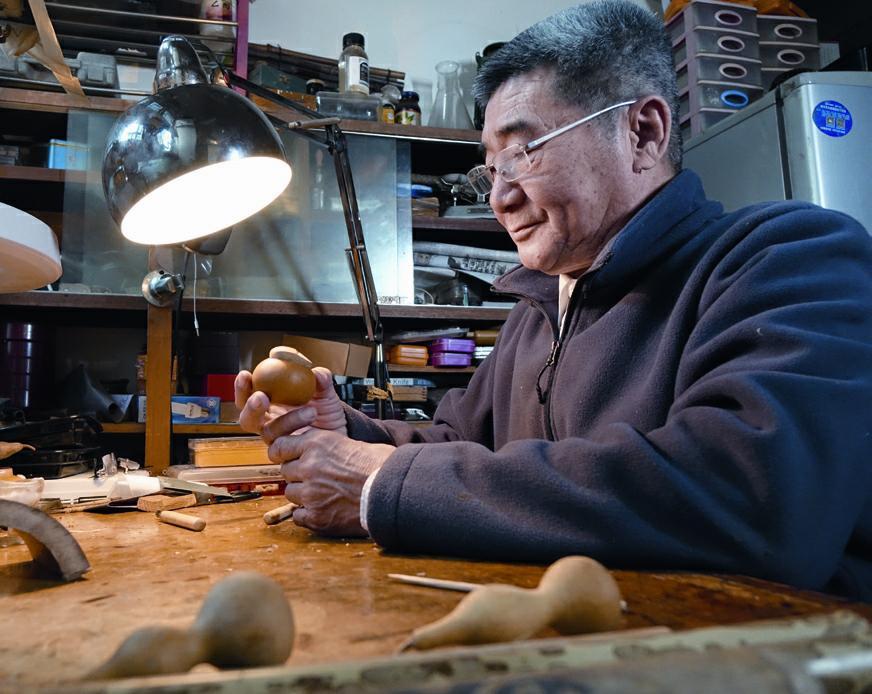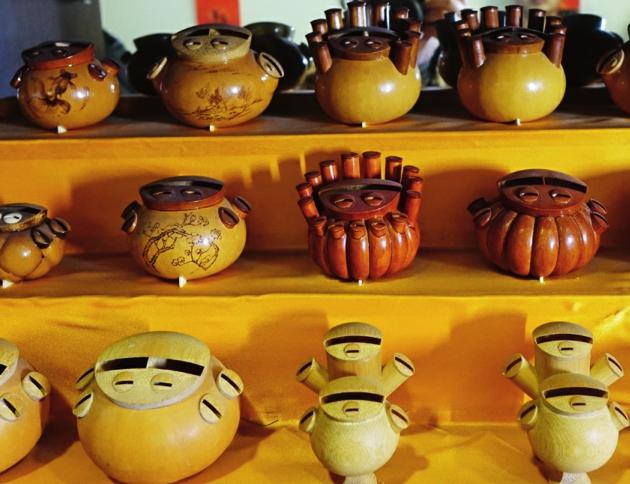The Pigeon Whistle:A Defining Sound of Old Beijing
By staff reporter JIAO FENG


IF you have ever watched a movie that featured old Beijing, there is a good possibility that it con- tained a scene with a flock of pigeons flying over quadrangular dwellings (siheyuan), giving off a uniquely harmonic buzzing sound as they flew by. That sound is what local residents remember when they think of old Beijing. As one saying about Beijing puts it, in Beijing you can find “fermented soybean drink, deep-fried dough sticks, the Bell and Drum towers, blue skies, white clouds, and pigeon whistles.” Every city has unique sights and sounds that define it, and the “sound of old Beijing” is the pigeon whistle.
Pigeon whistles (also called pigeon bells) are whis- tles that are tied on the tails of pigeons so that when they fly, the air that flows through the whistle creates a harmonic sound. Over the last several centuries, Beijing residents have liked to raise pigeons and let them soar through the skies every day. Regardless of whether it is a windy or sunny morning in spring or a cloudless day in late autumn, people can always see a flock of pigeons flying around in the sky and hear the melodious sound that they make while they fly. For this reason, the sound of pigeon whistles has become one of the symbols of Beijing, and was called by the renowned artist of Peking Opera Mei Lanfang“a symphony in the sky.” Up until the 1950s, pigeon markets in Beijing were very active, and pigeons could also be purchased at many temple fairs.
But with the passing of time and advancement of urban development, fewer and fewer people in Beijing are raising pigeons. Consequently, the sight of pigeons flying around with their accompanying harmonic sound is becoming increasingly rare. Pigeon whistles today have become a collectors item and a memory of the past. In 2014, the art of making Beijing pigeon whistles was added to the list of Beijings intangible cultural heritages.
Tracing the History
The art of making pigeon whistles has quite a long history in China. During the Northern Song Dynasty(960-1127), records tell how the army of the Western Xia Kingdom used pigeon whistles as military signals when attacking the Song army. By the era of the Southern Song Dynasty (1127-1279), pigeon whistles had already spread among the common people. Later, in the early part of the Qing Dynasty (1644-1911), the country enjoyed a period of peace. During that period, the soldiers of the Eight Banners regiment had lots of leisure as they were stationed in Beijing instead of being mobilized for campaigns, and received allowances of money and grain from the state. As a result, they began to develop various hobbies, including raising birds, fish, and crickets. The more time they spent on their hobbies, the more they perfected them, and soon these refined techniques and hobbies became mainstream.
For example for those who raised pigeons, in addition to paying attention to the pedigree and appearance, they also invested a lot of time and energy in the training, of which pigeon whistles were a part. Raising pigeons to wear whistles became a trend, and with that developed various kinds of pigeon whistles. The techniques of making whistles became more refined, and the sound produced by the whistles became more beautiful — in the end, these whistles became a “toy”in their own right, giving rise to a unique pigeon whistle culture.
Traditionally people in Beijing call the task of raising pigeons “circling pigeons.” The reason for that is that twice a day, once in the morning and once in the evening, pigeon owners release the birds to fly freely around in circles in the open air above their homes, flying higher and higher until they touch the clouds. The cooing of the pigeons together with the wind blowing through the whistle and the passers-by turning their heads to see where the heavenly orchestra sound is coming from brought pigeon keepers much joy and satisfaction.
Different kinds of whistles were used for different kinds of flocks of pigeons which produced different kinds of sounds. Carrying different styles of whistles, each flock of pigeons “performs” a beautiful harmony as if they were a symphony of birds performing in the skies. The rhythm produced by the pigeons is especially distinct when the pigeons fly right and then left in an even formation. The owner whose pigeons produced the best sounding whistle tone and had the greatest number of pigeon whistles would be admired by other pigeon raisers.
Various Styles and Schools
Pigeon whistles are usually made from bamboo or gourd. The bamboo pole or gourd is hallowed out and then a piece of carved bamboo is mounted on the top with a hole for the air to pass through. Some pigeon whistles have multiple wholes, in order to produce a fuller sound with different resonance as pigeons fly back and forth in the sky.
Beijing pigeon whistles are divided into four main types according to their shapes: Gourd-type — whistles made from round gourds; tubular type — whistles made with a row of lined-up reed tubes or bamboo pipes; platform type — whistles made with many rows of lined-up tubes attached to a platform that serves as a base; combined type — whistles made with a combination of gourd and a number of tubes and pipes. These different kinds of pigeon whistles produce different kinds of sounds. For instance, the tubular whistle will make a more crisp sound, while the sound produced by the gourd whistle is deeper. In addition, there are strict rules which the whistles must adhere to regarding the pitch difference between each whistle, whether it is a major second or minor third step difference. In this way, the sound produced by the whistles is harmonious. Taking into consideration that pigeons carry the whistles on their back when they fly, the material of each whistle must be as thin as paper and as light as a feather. Even the large whistles covered with lacquer are no heavier than eight grams.
The process of making whistles includes several steps: designing, choosing material, gouging, splitting, fitting, bonding, sanding, and finally lacquering— quite an elaborate process. The simplest pigeon whistle takes two whole days to complete, while the more complex ones take longer. The most important part of the pigeon whistle is the sound it produces. A miniature pigeon whistle must have a harmonious tone as well as be able to produce sound in a clear and melodious way. This requires careful designing as well as time- and labor-intensive sanding and molding required on the part of the craftsman.
When the whistle is ready to be tied on the pigeon, there are also particular details which should be paid attention to. Owners select the root of the four center feathers of the pigeons tail, and then tie the whistle to the feathers with a cotton thread about one centimeter from the pigeons rear. The opening of the whistle should face forward, and the posterior of the whistle should be placed in the center gap of the four center feathers. By doing this, the mouth of the whistle hangs under the tail feathers and is fastened tightly with a steel wire. With the whistle mouth embedded in the gap of the pigeons tail feathers, the rump and cotton thread can then prevent it from moving regardless of how much the pigeon moves in air.
Back in the early days, each craftsman who made pigeon whistles would engrave the characters of their name on the whistle, just like calligraphy artists stamp their name on their artistic work. The four famous whistle craftsmen in the Qing Dynasty had the names of Hui, Yong (Yong the senior), Xing, and Ming. Later during the Republic of China (1912-1949), in addition to Yong the junior, there were other craftsmen by the names of Xiang (Zhou Chunquan), Wen (Tao Zuowen), and Hong (Wu Yutong). The general name for these artists was the “eight main artists” of pigeon whistles.
Even though Beijing pigeon whistles were popular because the material was inexpensive and most people regarded the craft as a pastime for personal enjoyment, the famous craftsmen did not take on apprentices to pass on their skill. Everyone had to figure out how to make whistles by themselves. As a result, with the decrease of people who raise pigeons as a hobby, the number of people who know the skill of making pigeon whistles is also decreasing. Today, very few people know how to make quality pigeon whistles, and this has resulted in the near loss of this craft.
Preserving Pigeon Whistles
Zhang Baotong, a 70-year-old gentleman who lives in Xuanwumen of Beijings Xicheng District, used to be an engineer in a state-owned enterprise, a typical man of science and engineering. But because of a coincidence, he became the inheritor of the Beijing intangible cultural heritage handcraft.
During his childhood, Zhang was a neighbor of one of Beijings four renowned whistle makers Tao Zuowen and shared the same yard with him. Tao had no wife or children and lived alone. In his later years as he began to age, Tao was cared for by the Zhang family until his death.
Whistles with the “Wen” character are characterized by a round upper part, have smooth lines, can reduce air resistance, and are light and easy to carry for the pigeons when they fly. In addition, the workmanship is quite exquisite. Tao used pieces of bamboo and spliced them together, making it look like an orange after it is pealed. Even the bottom of each petal tip cluster fit tightly together. Zhang spent lots of time during his childhood around Tao. When he was around seven years old, he began to imitate Tao in his work, then at the age of 11 he began to formally learn how to make pigeon whistles. Over time, Zhang mastered all the skills of making pigeon whistles. Raising pigeons and making whistles was just a personal hobby that he enjoyed doing during his spare time, but it soon became the central activity of his spare time.
After Tao passed away, the pigeon whistles with his character “Wen” became rare collectors items among pigeon whistle lovers. One day, a cultural relic expert, Wang Shixiang, in an effort to find another pigeon whistle with the “Wen” character on it to match his collection of pigeon whistles made the acquaintance of Zhang. In the end, Zhang made him a new whistle which so resembled the one he already had, that he himself could hardly tell the difference between them. Sometime later, Wang visited the United Sates and presented it as a gift to the Field Museum of Natural History in Chicago. When the museum staff compared it with their collection of other pigeon whistles from Beijing with the “Yong”and “Xiang” characters on them, his work was of equal quality.
In addition to passing on the tradition of the craft of pigeon whistles, Zhang has also created some new styles of whistles. He started using walnut shells for the first time as material, broadening the sphere of material used in making pigeon whistles. In an article by Wang Shixiang, he described Zhang as an artist that makes innovations to pigeon whistles based on the “Wen” character style, and thus he has “created a‘Tong style of pigeon whistle in addition to the eight renowned artists of this art in the past, and a title which he truly deserves.”
All these compliments and praise Zhang has received have greatly encouraged him as well as impressed on him his responsibility to pass on the skill of making Beijings unique pigeon whistles. To this end, he broke with the tradition of pigeon whistle makers in the past, and has taken on two apprentices successively. Now, under the tutelage of Zhang, these two apprentices have learned the skills of making pigeon whistles and also taken on their own apprentices. Thus, the “Wen” style of pigeon whistles has been handed down to the fourth generation.
Today, skyscrapers have replaced the traditional quadrangle dwellings with courtyards of old Beijing, making the environment unsuitable to raise pigeons, lacking the space pigeons need to move around. As peoples lifestyles change, the classical sound of the symphony of pigeons flying over Beijing is slowly receding into memories of days gone by. Fortunately, Beijing opened the first sound museum in 2012. In the museum, there are records of the history and memories of old Beijing preserved in sound which already have or are in the process of disappearing, and among those old sounds are also ones made by pigeon whistles.

